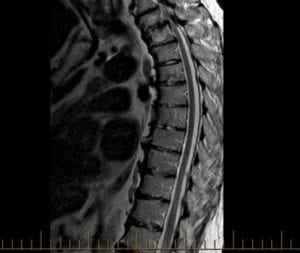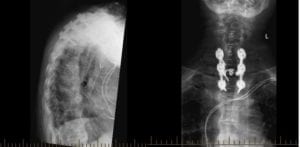Going off legs: thoracic myelopathy
Written By: Stephen Byrne Neurosurgeon and Complex Spine Surgeon
Most unstable spinal fractures affect the thoracolumbar junction or the cervical spine. Fractures elsewhere in the spinal column tend to be stabilised by the rib cage and rarely cause neurological deficits. Whenever a fracture causes spinal cord compression elsewhere in the thoracic spine, a secondary process such as infection (osteomyelitis) or neoplasm (primary or secondary) is more likely to be present. With advancing age, the transitional cervico-thoracic region is subject to degenerative and osteoporotic changes and spinal cord compression can occur.
In a recent case of an 86 year old man with a history of progressive gait disturbance and recurrent falls, who had previously lived independently along with his wife, they were both ‘high functioning’ and in good health. Recently, he had began to use a 4 wheel walker to get around his home and had stopped going out. He had a pacemaker and was a Jehovah’s Witness. Neurologically, it was noted that he had a left lower limb monoparesis 2/5 proximally and 4+/5 distally and a T4 sensory level. He had an ASIA D incomplete spinal cord injury on the ASIA impairment scale. His CT and MRI scan demonstrated a thoracic compression fracture and translation of one thoracic vertebra over the other along with some degenerative changes causing a severe spinal stenosis at T2/3 and cord oedema. The natural history of this condition in an elderly patient is inevitable loss of independence, eventual paraplegia and a high risk of death due to complications of immobility.
Pre operative T2 sagittal MRI showing translation of T2 over T2 and cord compression with cord oedema

Due to the progressive and emergent nature of the patients presentation and after a frank discussion of the risks and benefits of surgery versus non-operative care, surgical decompression of the spinal cord and stabilisation of the fracture was recommended. The patient underwent a T2/3 decompression and T1-3 pedicle screw fixation and was managed in Intensive Care for 24 hours post operatively. After a further three weeks of inpatient rehabilitation, the patient was discharged home. The patients walking had improved significantly and the strength in their legs had almost normalised at the final review. Due to ongoing problems with proprioception however, the patient was still using a 4 wheel walker but with the aim that he can dispense with this in time – an excellent result.
Post operative xrays showing pedicle screw fixation from T1-T3

Thoracic disc pearls
- Patients with complete or incomplete cord injuries due to fracture usually require surgery.
- Patients with thoracic fractures (other than thoraco-lumbar junction) and neurological deficits should be actively investigated for secondary processes such as cancer, infection and osteoporosis using CT, MRI and bone scans.
- Whether to proceed with surgery requires a full and frank discussion with the patient and their family about the natural history or their condition and what surgery can be reasonably expected to achieve.
